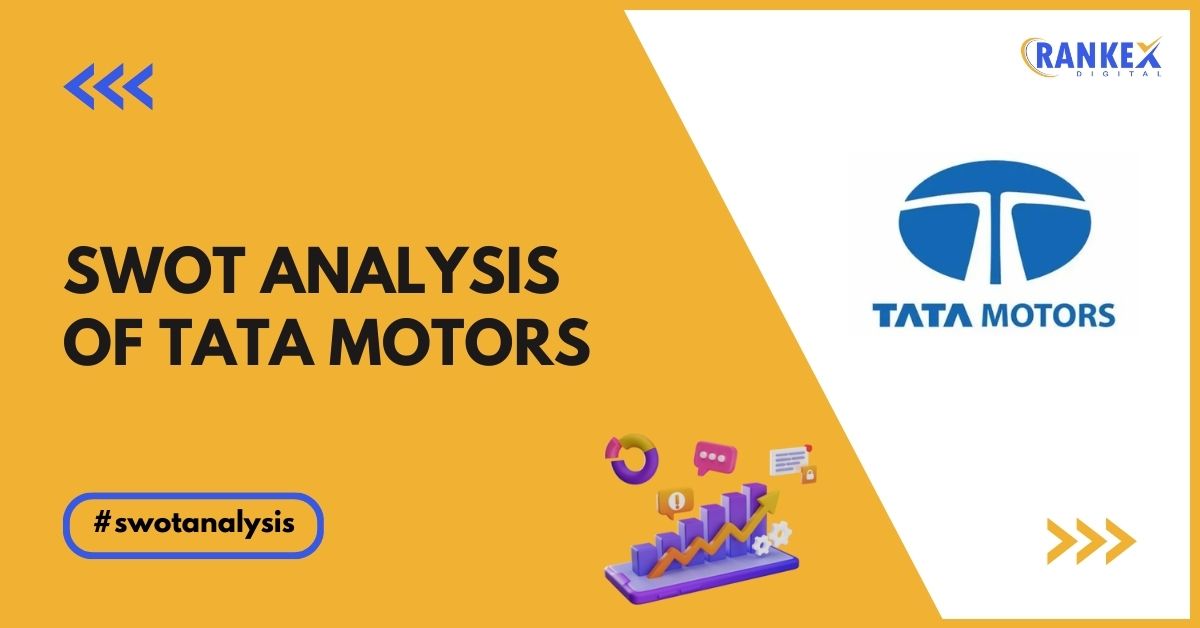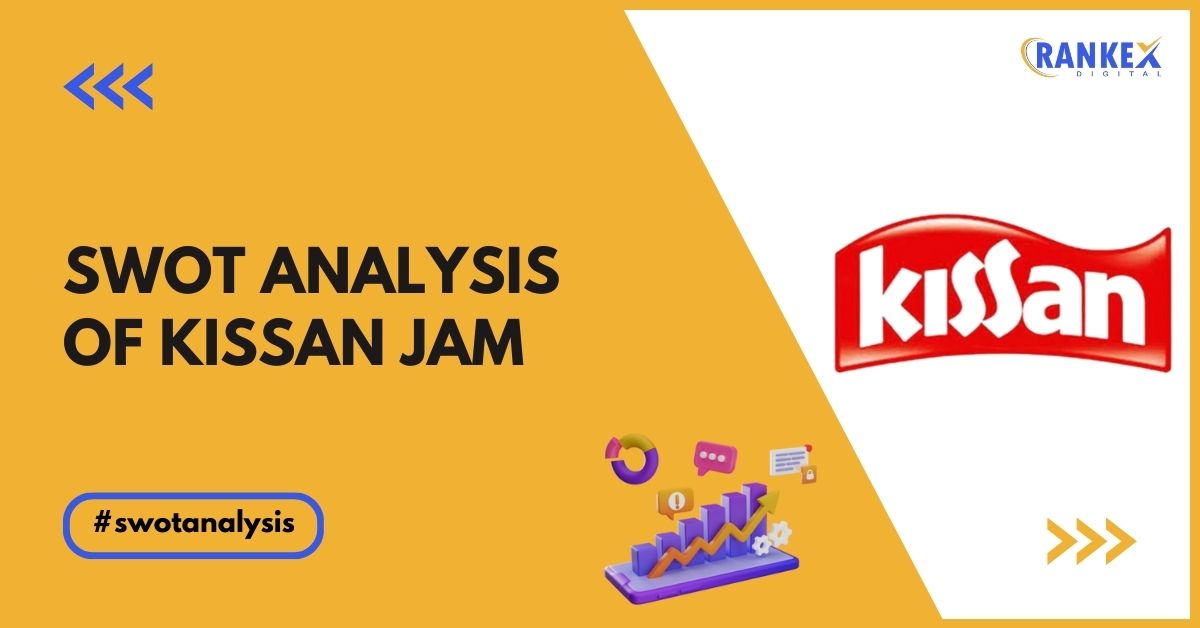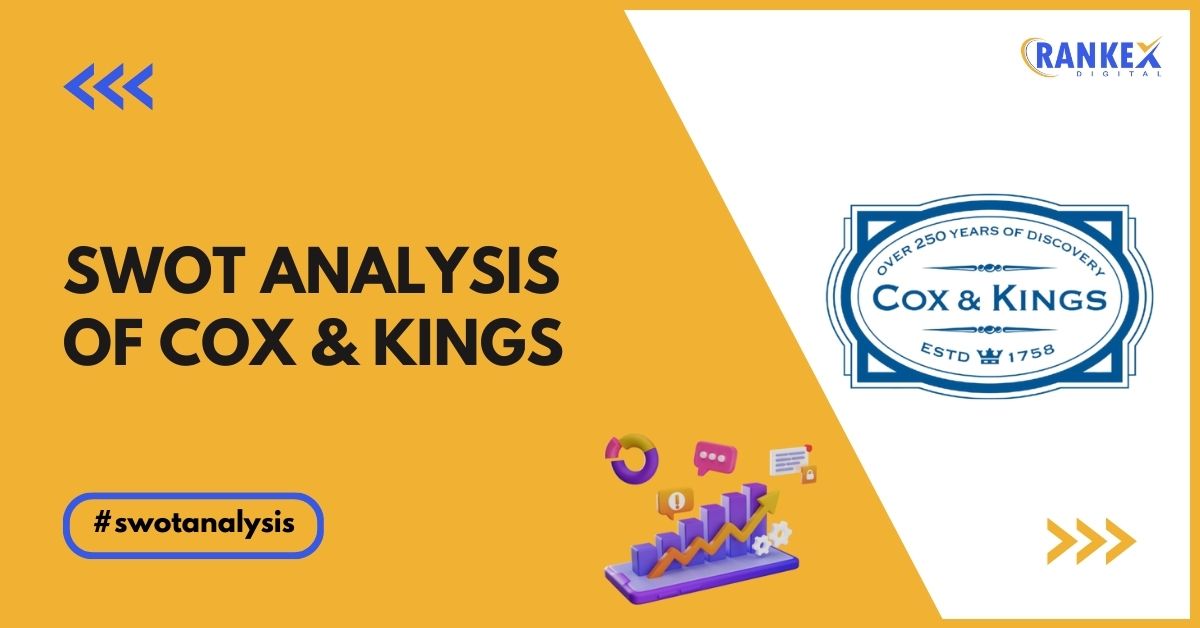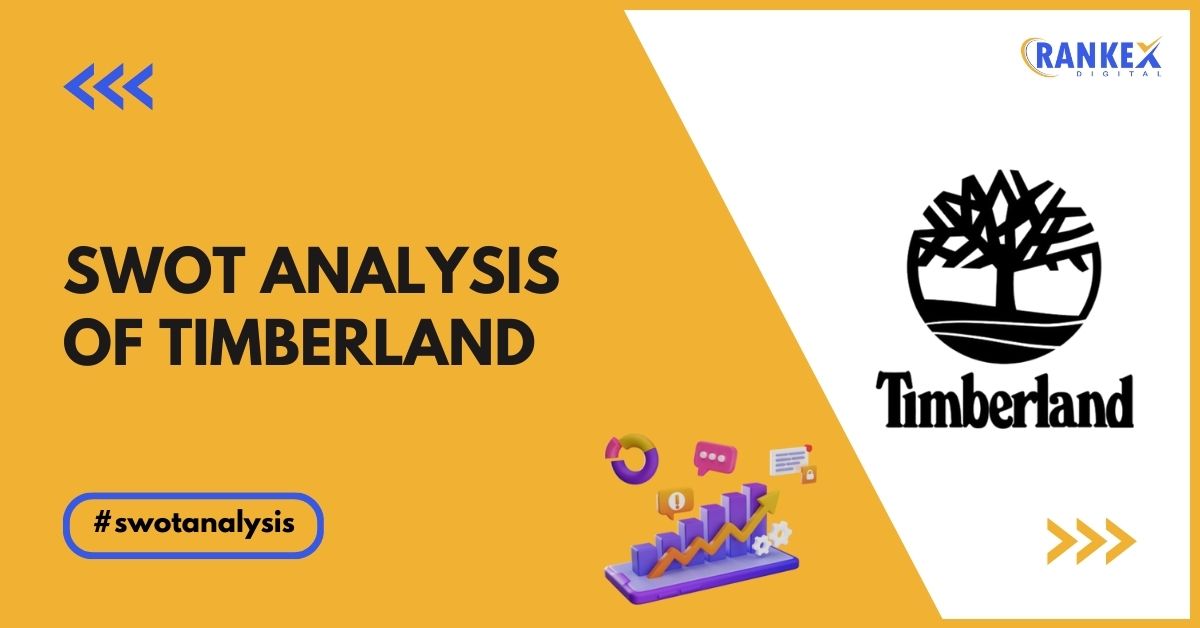Tata Motors, a flagship company of the Tata Group, is one of India’s largest and most influential automotive manufacturers. With a diverse portfolio that includes cars, commercial vehicles, and electric vehicles, Tata Motors has established a significant presence in both domestic and international markets.
Understanding the strengths, weaknesses, opportunities, and threats (SWOT) of Tata Motors is crucial for analyzing its competitive position and future growth potential. This article provides a comprehensive SWOT analysis of Tata Motors, exploring its key attributes and market dynamics.
Table of Contents
Overview of Tata Motors
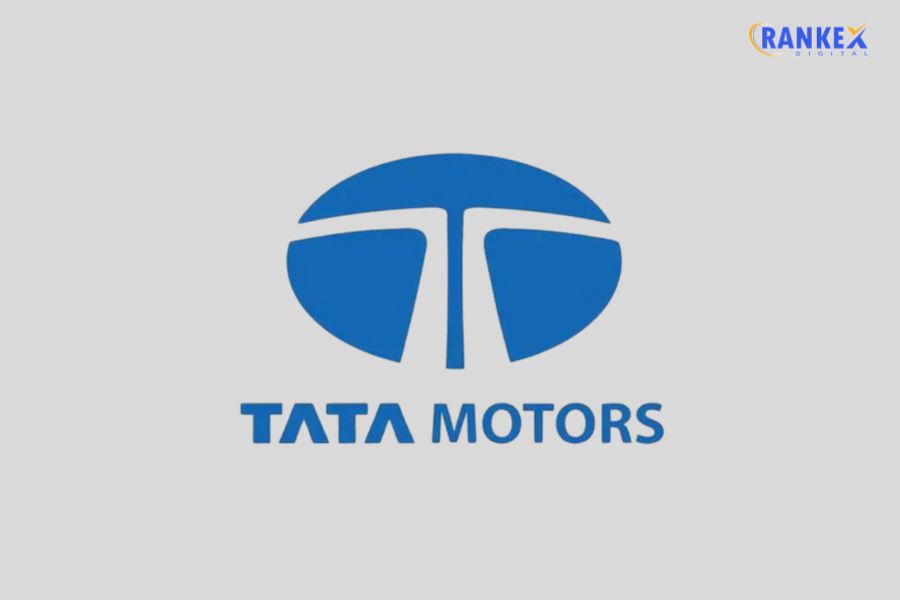
Tata Motors was founded in 1945 as Tata Engineering and Locomotive Co. Ltd. (TELCO) to manufacture locomotives and other engineering products. It entered the automotive sector in 1954 with the production of commercial vehicles in collaboration with Daimler-Benz.
Headquartered in Mumbai, Maharashtra, Tata Motors produces a wide range of vehicles, including passenger cars, trucks, buses, and military vehicles. It also owns the luxury car brand Jaguar Land Rover (JLR).
Tata Motors is a key player in the Indian automotive industry and has a growing presence in international markets.
Quick Stats About Tata Motors
| Founder | J.R.D. Tata (Tata Group) |
|---|---|
| Year Founded | 1945 |
| Origin | Mumbai, Maharashtra, India |
| No. of Employees | 78,906+ |
| CEO | N. Chandrasekaran (Chairman) |
| Company Type | Public (Tata Group) |
| Market Cap | $30 Billion |
| Annual Revenue | $40 Billion (FY 2023) |
| Net Profit | $1.5 Billion (FY 2023) |
Current News of Tata Motors
- Electric Vehicle Expansion: Tata Motors is aggressively expanding its electric vehicle (EV) lineup, with plans to introduce several new models to capitalize on the growing demand for EVs in India and abroad.
- Global Expansion: Tata Motors continues to strengthen its international presence, particularly through its Jaguar Land Rover (JLR) brand in Europe, North America, and China.
- Sustainability Initiatives: Tata Motors is investing in sustainable practices, including the development of green vehicles and initiatives to reduce its carbon footprint in manufacturing.
- Collaboration with Tech Companies: Tata Motors has been collaborating with tech firms to enhance its connected car technology and introduce advanced features like autonomous driving.
SWOT Analysis of Tata Motors
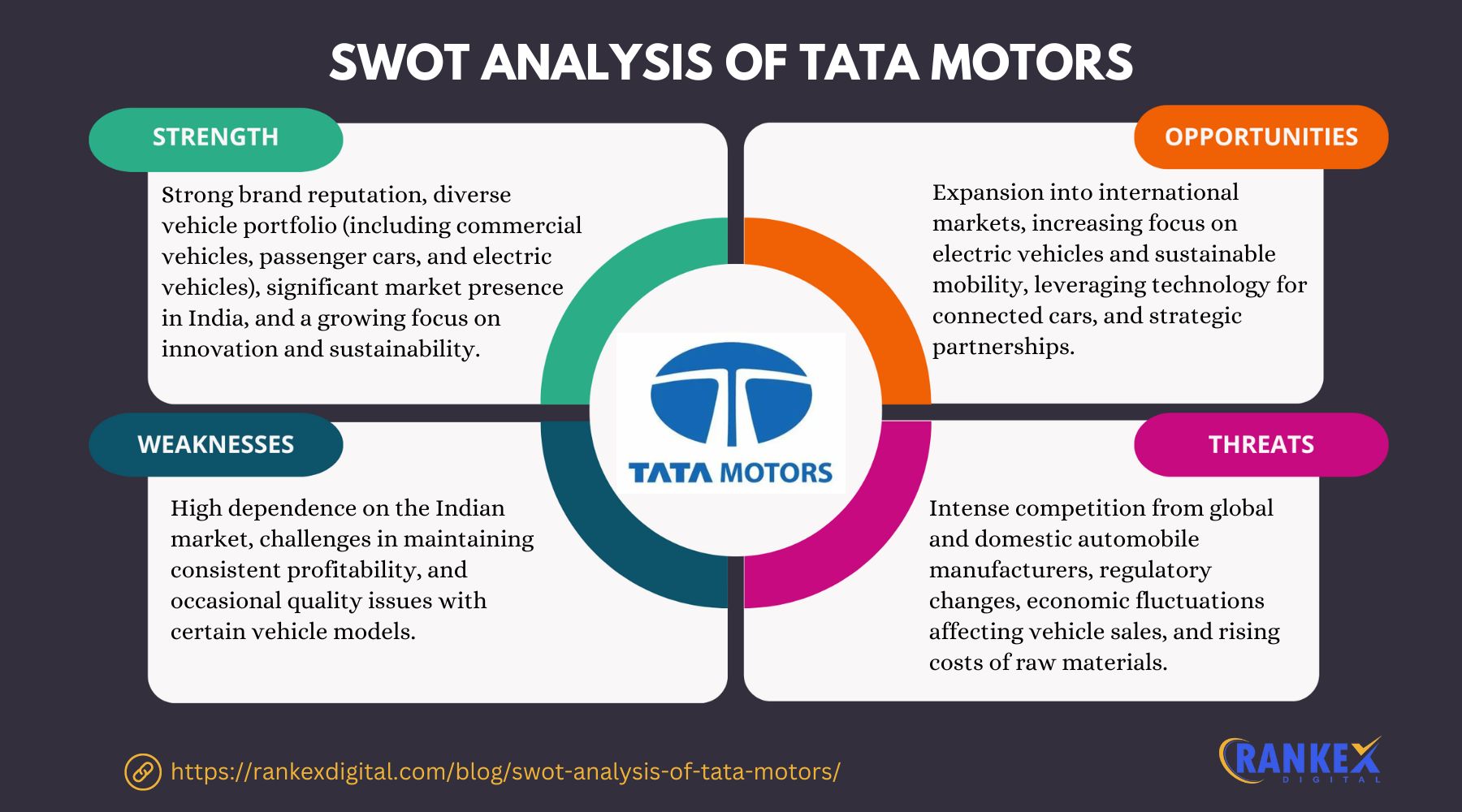
Strengths of Tata Motors
- Diverse Product Portfolio: Tata Motors offers a wide range of vehicles, from affordable passenger cars to luxury SUVs and heavy commercial vehicles, catering to various market segments.
- Strong Brand Reputation: Tata Motors is known for its reliability, durability, and value-for-money vehicles, particularly in the Indian market.
- Global Presence: Through its acquisition of Jaguar Land Rover, Tata Motors has a significant presence in international markets, particularly in the luxury vehicle segment.
- Innovation in EVs: Tata Motors is a leader in the Indian electric vehicle market, with a growing lineup of electric cars and a focus on sustainable mobility solutions.
- Robust Manufacturing Capabilities: Tata Motors has extensive manufacturing facilities in India and abroad, allowing it to scale production efficiently and meet market demand.
Weaknesses of Tata Motors
- Dependence on Indian Market: A significant portion of Tata Motors’ revenue comes from the Indian market, making it vulnerable to economic fluctuations and regulatory changes in the country.
- Jaguar Land Rover Challenges: While JLR is a valuable asset, it has faced challenges such as declining sales in key markets, high costs, and exposure to Brexit-related uncertainties.
- High Debt Levels: Tata Motors has high levels of debt, which can strain its financial resources and limit its ability to invest in new technologies and expansion.
- Quality and Reliability Issues: In the past, Tata Motors has faced criticism for issues related to vehicle quality and reliability, particularly in its passenger car segment.
- Limited Market Share in Developed Markets: Despite its global presence, Tata Motors has a relatively small market share in developed markets like the U.S. and Europe outside of the JLR brand.
Opportunities for Tata Motors
- Expansion in Electric Vehicles: The global shift towards electric mobility presents a significant opportunity for Tata Motors to expand its EV portfolio and capture market share, both in India and internationally.
- Growth in Emerging Markets: Tata Motors can capitalize on the growing demand for affordable and durable vehicles in emerging markets across Asia, Africa, and Latin America.
- Technological Innovation: Continued investment in connected car technology, autonomous driving, and advanced safety features can enhance Tata Motors’ product offerings and competitiveness.
- Partnerships and Alliances: Strategic partnerships with technology companies, other automakers, and startups can help Tata Motors access new markets, technologies, and business models.
- Sustainability Initiatives: Emphasizing sustainability and green manufacturing can enhance Tata Motors’ brand image and appeal to environmentally conscious consumers and investors.
Threats to Tata Motors
- Intense Competition: The automotive industry is highly competitive, with major global players like Toyota, Hyundai, and Volkswagen vying for market share, as well as domestic rivals like Mahindra & Mahindra and Maruti Suzuki in India.
- Economic Uncertainty: Global economic fluctuations, such as recessions, inflation, or currency volatility, can impact consumer demand and Tata Motors’ profitability.
- Regulatory Changes: Changes in environmental regulations, safety standards, and trade policies can affect Tata Motors’ operations and increase compliance costs.
- Supply Chain Disruptions: Tata Motors relies on a complex global supply chain for components and materials, making it vulnerable to disruptions caused by geopolitical tensions, pandemics, or natural disasters.
- Technological Disruption: Rapid advancements in automotive technology, such as electric and autonomous vehicles, could outpace Tata Motors’ ability to innovate and adapt, particularly in its legacy internal combustion engine (ICE) vehicles.
Top Competitors of Tata Motors
- Maruti Suzuki: The largest car manufacturer in India, known for its extensive range of affordable vehicles and dominant market share in the passenger car segment.
- Mahindra & Mahindra: A key competitor in both the passenger and commercial vehicle segments, with a strong presence in SUVs and tractors.
- Hyundai: A major global player with a significant presence in the Indian market, offering a wide range of vehicles from compact cars to SUVs.
- Toyota: Known for its reliability and innovation, Toyota competes with Tata Motors in the passenger and commercial vehicle segments, particularly in India and Southeast Asia.
- Ashok Leyland: A leading competitor in the commercial vehicle segment, particularly in trucks and buses, with a strong presence in India and export markets.
Conclusion
The SWOT analysis of Tata Motors highlights its diverse product portfolio, strong brand reputation, global presence, innovation in electric vehicles, and robust manufacturing capabilities as key strengths. However, the company faces challenges such as dependence on the Indian market, issues with Jaguar Land Rover, high debt levels, and intense competition.
Opportunities for Tata Motors lie in the expansion of electric vehicles, growth in emerging markets, technological innovation, strategic partnerships, and sustainability initiatives. On the other hand, threats include economic uncertainty, regulatory changes, supply chain disruptions, and technological disruption.
By leveraging its strengths and opportunities while addressing its weaknesses and threats, Tata Motors can continue to be a leader in the automotive industry and drive future growth.

